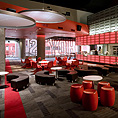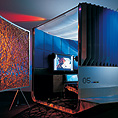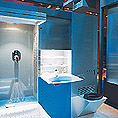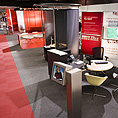











Continued |
|
In the 1990's the methodologies of prototyping and scenario mapping originally used for the development of industrial design products were taken one stage further; developing strategies for the prototyping of processes rather than objects. Designers using prototyping believe that change in the marketplace will only be accepted if it conforms to the expectation that change must bring an improvement to the performance of a product or service. The resulting focus for these designers has been to locate products within the broader idea of service networks that support contemporary customer expectations in more robust ways. These often utilise information technology to create appealing and rich service models where the operation of the network can substitute for the operation of multiple products. These service networks are called 'product service systems'. In developing the designs of product service systems, designers have adapted the prototyping model to construct and test prototypes of business and social processes. Here the focus of the prototyping scenario is a social and technical network designed to provide a service. Herman Kahn working for the Rand Corporation in the 1960's was the first scenario builder. He defined a scenario as a description of a possible alternative future, aimed at stimulating concrete actions in the present in order to control and orient the future. In order to construct a prototype 'product service system' scenario the focus becomes one of modelling the social interaction. Given the ephemeral nature of many service elements one of the key strategies for this kind of prototyping is to ensure that it is immersive, allowing the user to imagine the experience of the final outcome, even if this is done in a fragmentary fashion. This presents a significant challenge; how to quickly draw people into an imaginary world where the new idea or innovation might already exist. To do this designers grabbed a range of existing tools to create a design plan, a series of processes adapted from industrial design, interaction design, theatre production, movie making, fashion, services marketing and blueprinting in a way that was comparable to the car industry's use of concept cars. The evolution of this kind of prototyping has seen the development of a broad set of techniques. These range from mocked-up advertisements for proposed services to quickly engage in user dialogue to system maps that show the relationships between the actors and the operational elements and to advertising storyboards. 'Bodystorming' and videoing short stories or interactions are other ways to quickly engage users in role-playing, to test and evolve process elements of the system and then record the results for later analysis. Prototyping needs to be quick and dirty, using techniques that are cheap, fast, easy to use and able to allow changes on the spot. Cardboard, sticky tape and butchers paper are a good starting point. |
|
One of the first companies to address the telling of stories through architecture and a spatial experience was the Disney Corporation with the development of Disneyland. Using the narrative structures and techniques developed in movie making, such as story boarding and choreography, Disney created environments and the experiences based on stories. These stories or scripts gave the primary reason for being for every element included in the architectural design of Disneyland. The assemblage of contextual details was designed to act as a stage set of props to support the customers' experience. For Disney, capturing the drama is more important than the individual designed elements that make up the physical environment. For Disney the product on offer driving the experience is a set of escapist narratives that immerse the visitor. For other companies that offer might be banking or food or shoes. In each case the product becomes just one actor, albeit an important one, in an elaborate script in which the customer plays the lead role. |
|
Central to the success of any innovation is its relevance to emerging market expectations. The question this line reasoning begs for designers and their commercial clients is: Can we focus on designing and delivering innovative experiences for our customers by using a managed process of service and product prototyping? How do we write the appropriate script that will best reveal or make accessible the attributes of the product or service we would like to develop or test? How do we ensure that this script or narrative will be appealing or relevant to potential consumers? While we as designers along with our key client stakeholders can make a series of assumptions about what the appropriate script might be for a new architectural project, business process or product, if we rely on a set of untested assumptions or merely repeat an existing script then the project will either appear too risky or simply not deliver an outcome with any innovation, thereby failing to deliver one of the key objectives of experience design; delivering a unique experience. |

|
By prototyping the scripts, processes and spaces that are to drive or shape the intended experiences, designers can improvise and test new ideas in a controlled environment as part of the design process. In his book Serious Play, How the Worlds Best Companies Simulate To Innovate, Michael Schrage observed that 'you can't invent the future without prototyping it' He observes that the process of building prototypes itself cannot only profoundly influence the way the design ideas are received, but also the very ideas themselves. The conversational dynamic set-up through a prototyping process can inform the possibilities of the design process in very rich ways, acting as a catalyst and a 'strange attractor' for new ideas and directions. This process is not collaborative design but it does recognise and pursue the diversity and complexity of contemporary design problems and the stakeholders and factors that shape their success or failure. This kind of prototyping as much harder than prototyping a chair. This involves the prototyping of a social artefact. Prototyping a new product service system requires prototyping all of the elements of the system. Invariably the mapping of the scenario will require the collection of data to construct a model of the potential actors and their relationships within the system. |
|
Designing for user experience and innovation |
page: 1 | 2 | 3 | 4 |
2008 © Crowd

